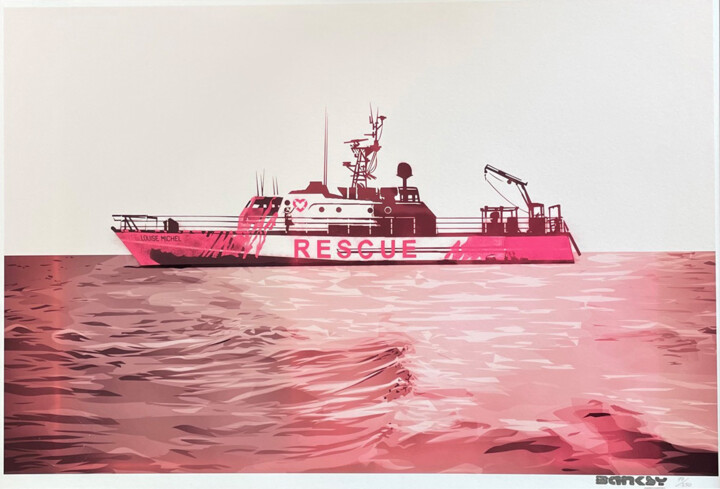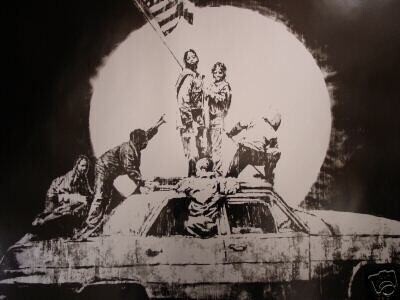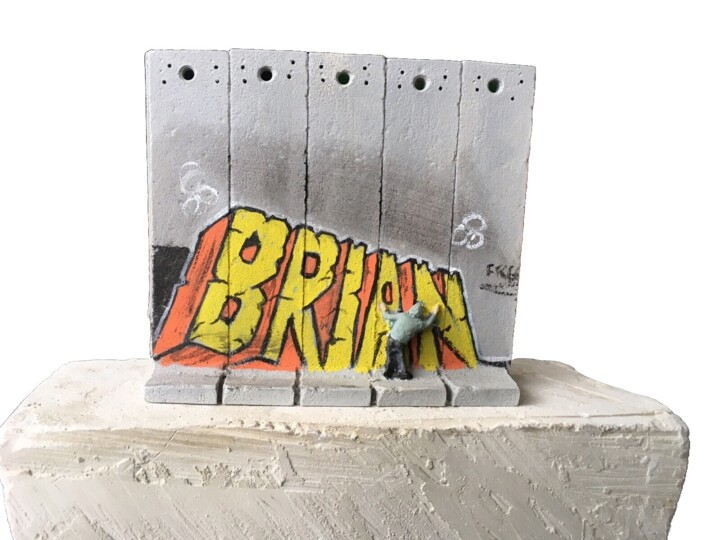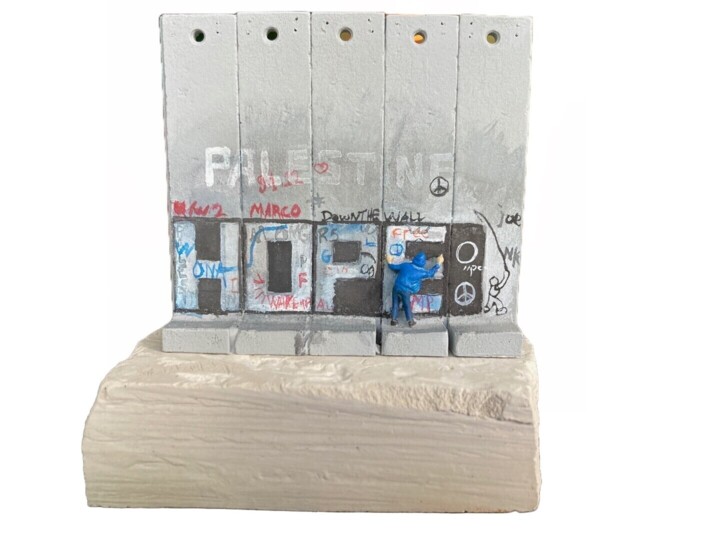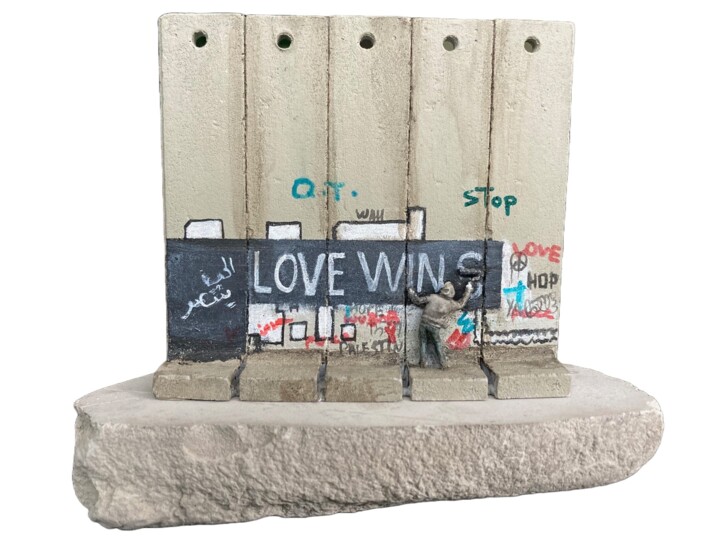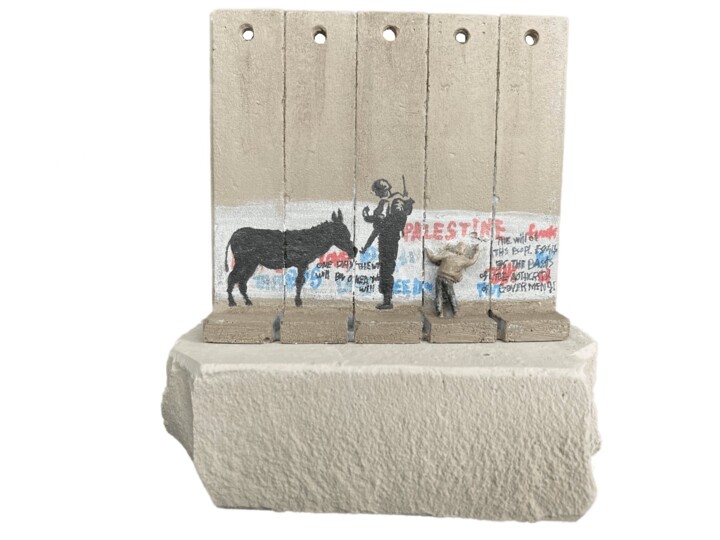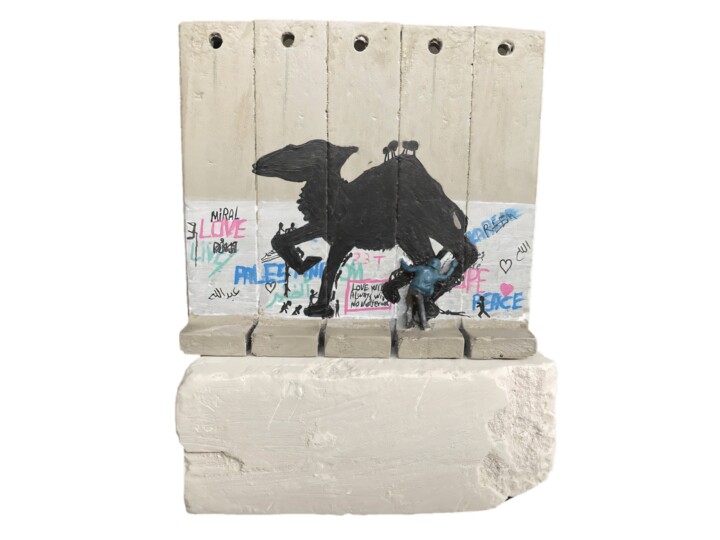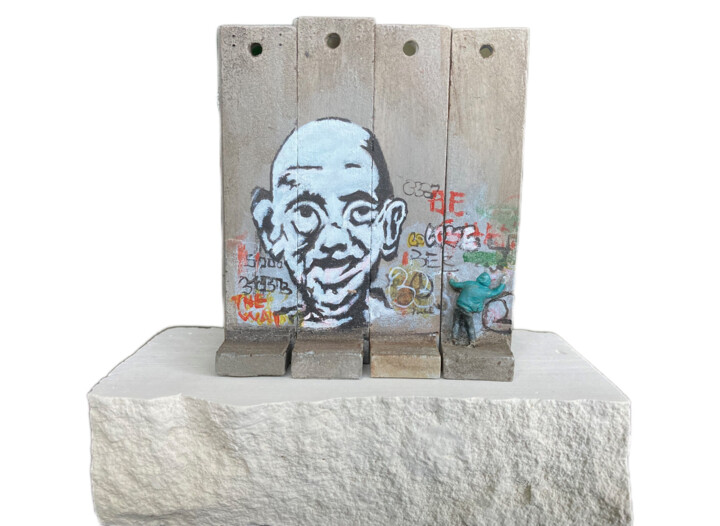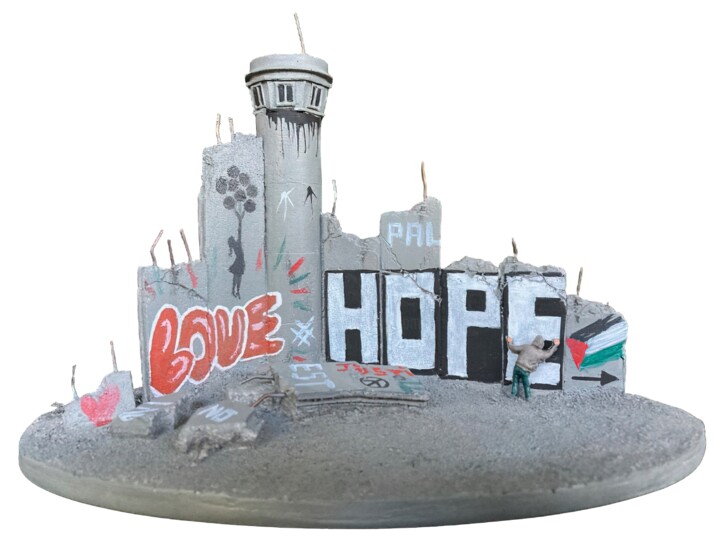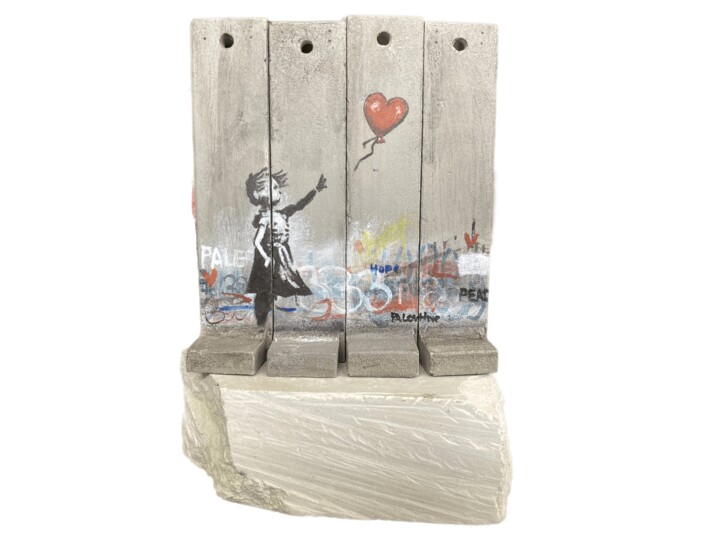Banksy, a pseudonymous street artist, political activist, and film director from England, has captivated the world with his enigmatic identity and provocative works since the 1990s. Known for his satirical street art and subversive epigrams that blend dark humor with graffiti, Banksy's distinctive stenciling technique has left a mark on streets, walls, and bridges globally. Emerging from the Bristol underground scene and influenced by graffiti artist 3D of Massive Attack, Banksy's art is both a form of social commentary and a statement on the transient nature of street art. While he no longer sells reproductions of his work, his public installations are highly sought after, often involving the physical removal of the walls they adorn. His acclaimed documentary "Exit Through the Gift Shop" premiered at the Sundance Film Festival and earned him an Academy Award nomination. In 2014, his cultural impact was further recognized when he was named Person of the Year at the Webby Awards.
Artist Biography:Banksy
Banksy, often hailed as the "king of provocation," is a pseudonymous street artist, political activist, and film director who has become one of the most prominent contemporary artists of our time. Since 1993, his versatile body of work—ranging from stencils and paintings to sculptures and installations—has made an impact across every continent. Banksy’s art, characterized by its dark humor and subversive themes, addresses human conditions and societal issues, often challenging viewers with its irreverent and satirical nature. Although his exact identity remains unconfirmed, it is widely believed that Banksy was born in Bristol, England, in 1974. His anonymity is a cornerstone of his artistic persona, enabling him to create and display his work under the cover of secrecy. This elusiveness has led to several high-profile stunts, such as his 2004 distribution of counterfeit currency featuring Princess Diana and his 2005 infiltration of major museums like the MoMA and the Louvre with his own artworks. Banksy's works often convey potent messages on topics like freedom and consumerism. Notably, his murals on the West Bank barrier and his depiction of a napalm victim accompanied by Mickey Mouse and Ronald McDonald serve as stark commentaries on oppression and capitalist culture. Despite the speculative frenzy surrounding his identity—with theories ranging from musician Robert Del Naja to former TV presenter Neil Buchanan—Banksy continues to focus public attention on his art rather than himself.
His influence extends beyond street art; Banksy directed the critically acclaimed documentary "Exit Through the Gift Shop," which premiered at the Sundance Film Festival in 2010 and earned an Academy Award nomination. His work's commercial value, although paradoxical to his anti-capitalist stance, has seen pieces auctioned for millions, reflecting his complicated relationship with the art market. Banksy's legacy, marked by his provocative and often controversial approach, challenges the conventional boundaries of art and continues to inspire debate and admiration worldwide. Between 2015 and 2018, Banksy created impactful artworks in the Gaza Strip to highlight its destruction, opened Dismaland in the UK as a satirical take on Disneyland, and painted murals in Calais addressing the migrant crisis. In 2017, he established the Walled Off Hotel in Bethlehem, and in 2018, he returned to New York, creating notable murals including one of imprisoned Kurdish artist Zehra Doğan. His 2018 Love is in the Bin stunt at Sotheby’s, where Balloon Girl partially self-destructed, made headlines. In 2018-2019, he created Season's Greetings in Wales, opened a pop-up shop to protect his trademark, and saw his Devolved Parliament painting sell for nearly £9.9 million. In the 2020s, Banksy continued his provocative work with pieces like Valentine's Banksy in Bristol, a tribute to NHS workers during the COVID-19 pandemic, and murals in Ukraine amid the Russian invasion. In 2024, a new mural in Upper Holloway, Islington, garnered attention for its immovable context.
Banksy's artistic techniques and influences remain enigmatic due to his secretive identity. It is speculated that he employs computers for some of his highly detailed stencil images, inspired by his need for speed and evasion from authorities during his early graffiti days. Transitioning to stencilling after a revelation under a garbage truck, Banksy developed intricate stencils to minimize time and enhance detail in his works. His style often combines striking imagery with poignant slogans, typically conveying anti-war, anti-capitalist, or anti-establishment messages featuring recurring motifs like rats, apes, and children. While stencils are traditionally hand-drawn or printed, Banksy's adaptation has sparked debate in the street art community, criticized by some purists as "cheating." His controversial 2018 artwork at Sotheby's, where a painting self-destructed through a shredder embedded in its frame during auction, exemplifies his provocative approach to art and commentary on consumerism and the art market, resulting in the creation of Love is in the Bin.
Street Art
Street art, a form of visual art created in public locations for public visibility, has evolved significantly from its early graffiti roots. It encompasses a variety of media and techniques, including spray paint, stencils, mosaic tiling, LED art, and even video projections. Unlike traditional graffiti, which is often illegal and defiant, street art aims to provoke thought and engage the public with clear messaging. This shift has led to street art being more commercially accepted, with some works being created through agreements or commissions. The use of urban spaces as canvases allows artists to reach broader audiences and address social and political issues, often through what some term "smart vandalism." The origins of modern street art can be traced back to New York City's graffiti boom in the 1960s, peaking in the 1980s with full-car subway train murals. This era also saw the rise of iconic artists like Keith Haring and Jean-Michel Basquiat. The 1980s marked a transition from text-based graffiti to visually conceptual street art, with notable contributions from artists like Richard Hambleton and collectives such as AVANT. The punk rock movement and anti-museum ideologies further fueled the street art revolution, promoting art in public spaces over traditional gallery settings.
Prominent locations like New York City's Bowery Mural have become historic sites for street art, attracting renowned artists and transforming from free graffiti zones to curated art spaces. Artists like René Moncada and Franco the Great have also left significant marks on urban landscapes, turning everyday city elements into canvases for artistic expression. Street art has gained mainstream recognition, with some artists successfully transitioning to the commercial art world. This crossover has seen street art motifs incorporated into advertising and design, with artists like Shepard Fairey creating iconic images such as the Barack Obama "Hope" poster. Street art tours in cities like Berlin, London, and Paris highlight the genre's popularity and its role in urban culture.
The legality and ethics of street art continue to be complex, with issues of ownership, vandalism, and copyright frequently arising. Notable cases, such as Banksy's "Mobile Lovers" and disputes involving corporations like H&M, highlight these challenges. In the United States, street art can find copyright protection if legally installed and original, but legal battles often hinge on the artwork's legal status and its removal or destruction.
Hope Walled Off Hotel Defeated Wall Section Sculpture (2018) by Banksy
Banksy, Hope Walled Off Hotel Defeated Wall Section Sculpture, 2018. Sculpture, Oil / Casting / Resin on Object, 14cm x 19.7cm / 0.27 kg.
Hope Walled Off Hotel Defeated Wall Section Sculpture (2018) by Banksy is a poignant miniature sculpture measuring approximately 14 x 19.7 x 12.9 cm (5 ½ x 7 ¾ x 5 in). Crafted from enhanced polymer resin, this artwork features a segment of the Palestinian separation wall adorned with iconic graffiti, reflecting the artist's trademark blend of political commentary and artistic ingenuity. Hand-painted by local artisans, each piece is unique and imbued with the spirit of its origin at the Walled Off Hotel in Bethlehem, Palestine. Sold exclusively at the hotel's gift shop, this sculpture comes with a purchase receipt acting as a certificate of authenticity, with a matching numbered base documented by Walled Off Hotel staff. Included in the sale is a certificate of authenticity from Marc Pairon of the Private Art Gallery, along with a welcome letter, business card, sweet, soap, and a copy of the book "BANKSY - THE WALLED OFF ART EDITIONS are SOLD OUT!" published by the Charles Catteau Foundation in 2020, which features this sculpture.
Mahatma Gandhi Walled Off Hotel Wall Section Sculpture (2020) by Banksy
Banksy, Mahatma Gandhi Walled Off Hotel Wall Section Sculpture, 2020. Sculpture, Oil / Casting / Resin on Object, 9cm x 7.8cm / 0.05 kg.
Mahatma Gandhi Walled Off Hotel Wall Section Sculpture (2020) by Banksy is a compelling miniature sculpture, measuring approximately 9 x 7.8 x 3 cm (without base). Crafted from enhanced polymer resin, this artwork features a segment of the Palestinian separation wall adorned with revered graffiti, set on a concrete base. Hand-painted by local craftspeople, the sculpture embodies Banksy's signature blend of artistic expression and social commentary. Exclusively available at the Walled Off Hotel gift shop in Bethlehem, Palestine, each piece comes with four original purchase receipts acting as certificates of authenticity, with numbered bases meticulously documented by Walled Off Hotel staff. Also included is a certificate of authenticity issued by Marc Pairon of the Private Art Gallery, alongside a copy of the book "BANKSY - THE WALLED OFF ART EDITIONS are SOLD OUT!" published by the Charles Catteau Foundation in 2020, which features this sculpture. The sale package also contains a Walled Off Hotel welcome letter, business card, sweet, and soap, enhancing the collectible value of this unique artwork.
Iconic Artwork
Banksy's diverse artworks capture attention through provocative themes and unexpected juxtapositions. His Anarchist Rat piece from 2004 in Sloane Square, London, features a rat holding an anarchist sign, symbolizing his frequent use of rats to comment on human society. In 2007, Banksy created a version of Pulp Fiction with Samuel L. Jackson and John Travolta holding bananas instead of guns, which was swiftly removed by authorities but later replaced with a second rendition featuring the characters in banana suits. Another notable work, NuNu in Bristol, depicts a naked man hanging from a window, sparking controversy that led to a unanimous council decision to preserve it on a sexual health clinic building. Banksy's artworks also extend globally, such as his Beach Boys series on the Israel-Palestine wall, promoting themes of peace with scenes of children and idyllic landscapes. Additionally, his Napalm artwork from 1994 reimagines the iconic photo of a napalm-burned Vietnamese girl alongside corporate mascots like Ronald McDonald and Mickey Mouse, highlighting his impactful and often satirical approach to art.
Art Market and Exhibition
Banksy's impact on the art market is profound yet paradoxical, characterized by both skyrocketing auction prices for authenticated works and the artist's staunch resistance to traditional commercialization. The value of Banksy's pieces fluctuates significantly based on factors such as rarity, size, technique, and thematic content. Notably, iconic works like Girl with Balloon and Love is in the Air have commanded prices in the millions at international auctions, reflecting their cultural and artistic significance. However, many of Banksy's creations are executed without permission in public spaces, complicating their legal status and marketability. Some of these unauthorized works have been removed, sold, or attempted to be sold, often amidst controversy and legal challenges. Despite his art's commercial success, Banksy maintains an anti-capitalist and anti-commercial stance, frequently refusing to sell his pieces or profit from their sale. Consequently, much of Banksy's oeuvre remains in situ in public spaces or within private collections, contributing to the enigmatic allure and rarity of his available works on the market.
Banksy's artwork Love Is in the Bin made headlines once again as it sold for a staggering £18.6 million ($25.4 million) at Sotheby's London auction, setting a record for the elusive artist. Originally gaining fame in 2018 when it shredded itself moments after being sold for £1 million ($1.4 million), the artwork was renamed and reauthenticated by Banksy after the malfunctioning shredder left it only partially destroyed. Sold by an anonymous European buyer who acquired it three years ago, the piece far exceeded its estimated value of £4 million to £6 million ($5.5 million to $8.2 million), fetching 18 times its previous purchase price. This sale underscores Banksy's skyrocketing auction success, with his market presence growing significantly in recent years, driven by a surge in both auction volume and average prices, culminating in 2021 becoming his most lucrative year yet.
Banksy's exhibition history reflects his profound impact on the art world, blending street art with institutional spaces in provocative ways. Notably, from October 2003 to May 2005, Banksy infiltrated esteemed venues like Tate Britain, the Louvre in Paris, and the Brooklyn and Metropolitan Museums in New York with his subversive artworks, challenging traditional gallery norms. Since 2000, Banksy's exhibitions, both authorized and unauthorized, have continued to captivate audiences globally. One standout unauthorized exhibition, "Laugh Now," held at the Moco Museum in Amsterdam, showcased his works in a commercial setting, echoing his disdain for unauthorized shows highlighted on his own website's 'Product Recall' section. Conversely, Banksy's authorized exhibitions, like "Cut & Run" in 2023 at the Gallery of Modern Art in Glasgow, exemplify his selective approach, offering audiences rare insights into his stencil artworks and creative process. Each exhibition marks Banksy's ongoing influence on blending street art's raw energy with the formalized spaces of the art world, challenging viewers to reconsider conventional boundaries of art appreciation.
The impact of Banksy's work transcends mere artistic expression, intertwining satire with profound social commentary that challenges established norms and ignites global discourse. Emerging from Bristol's underground scene, Banksy's enigmatic persona and provocative pieces have redefined the boundaries of street art, blurring the lines between vandalism and visionary creativity. His stenciled murals and installations, infused with dark humor and poignant symbolism, serve as powerful reflections on issues like capitalism, conflict, and societal injustice. Through audacious acts like self-shredding artworks and clandestine installations in prestigious museums, Banksy not only critiques but disrupts the art establishment itself, insisting on art's accessibility and its role in shaping public consciousness. By maintaining anonymity while achieving unprecedented auction prices and institutional recognition, Banksy embodies a paradoxical figure whose art challenges viewers to confront uncomfortable truths while celebrating the rebellious spirit of contemporary artistry.




 Selena Mattei
Selena Mattei

